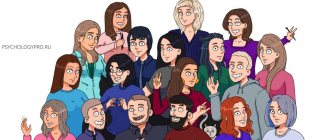What is an activity?
Activity is the purposeful and active influence of a certain subject of reality on a certain specific object, while this influence allows the subject to achieve a certain goal, thus satisfying his needs. Therefore, the activities involve:
- Subject , i.e. the actor himself, the person who is the source of activity;
- Object , which refers to the passive and inert side, and the subject’s influence is directed towards it. The object can be an inanimate object or thing, and other people (for example, students are subjects of educational activities), and the person himself, acting simultaneously as both the subject and the object of his own activity (for example, during training hours or self-study).
The content of an activity will not be determined only by the need that gave rise to it. The need only pushes the individual to begin active actions, but the content of these actions and the forms of their manifestation determine the goals, experience and requirements of a particular person or society.
Labor and other transformative activities are a prerequisite for the development and very existence of people and society; they are the ones who created modern man, his history, culture and science. In addition, there is an inextricable connection between activity and man; they cannot exist without each other. Man is the only species on Earth that has learned to transform the environment, and not just adapt to its conditions . For example, many centuries ago, people began to engage in agriculture and animal husbandry, and not just appropriate food through gathering, hunting and fishing.
The basis of activity is creativity and constructive activity, allowing people to go beyond the capabilities allocated to them by nature and create something fundamentally new, unknown to previous generations. By transforming his environment, a person not only changes himself and the world around him, but also establishes contacts with other people, adopts their experience and skills.
Personality
PERSONALITY is a phenomenon of social development, a specific living person with consciousness and self-awareness. Personality structure is a holistic systemic formation, a set of socially significant mental properties, relationships and actions of an individual that have developed in the process of ontogenesis and determine his behavior as the behavior of a conscious subject of activity and communication. Personality is a self-regulating dynamic functional system of continuously interacting properties, relationships and actions that develop in the process of human ontogenesis. The core formation of personality is self-esteem, which is built on the assessment of the individual by other people and his assessment of these others. In a broad, traditional sense, personality is an individual as a subject of social relations and conscious activity. The personality structure includes all the psychological characteristics of a person, and all the morphophysiological characteristics of his body - right down to the characteristics of metabolism. The popularity and persistence of this expanded understanding in literature seems to be due to its similarity to the ordinary meaning of the word. In a narrow sense, it is a systemic quality of an individual determined by involvement in social relations, formed in joint activities and communication.
According to A.N. Leontiev, personality is a qualitatively new formation. It is formed through life in society. Therefore, only a person can be a person, and then only after reaching a certain age. In the course of activity, a person enters into relationships with other people—social relationships, and these relationships become personality-forming. From the side of the person himself, his formation and life as an individual appear primarily as development, transformation, subordination and resubordination of his motives. This concept is quite complex and requires explanation. It does not coincide with the traditional interpretation - in the broad sense. The narrowed concept allows us to isolate a very important aspect of human existence associated with the social nature of his life. Man as a social being acquires new qualities that are absent if he is considered as an isolated, non-social being. And each person from a certain time begins to make a certain contribution to the life of society and individuals. That is why, next to the concepts of personality and personal, the concept of socially significant appears. Although this significant thing may be socially unacceptable: a crime is as much a personal act as a feat. To psychologically concretize the concept of personality, it is necessary to answer at least questions about what the new formation called personality consists of, how personality is formed, and how the growth and functioning of his personality appears from the position of the subject himself. The criteria for a mature personality are:
1) the presence of hierarchy in motives in a certain sense - as the ability to overcome one’s own immediate motivations for the sake of something else - the ability to behave indirectly. At the same time, it is assumed that the motives, thanks to which immediate impulses are overcome, are social in origin and meaning (simply indirect behavior may be based on a spontaneously formed hierarchy of motives, and even “spontaneous morality”: the subject may not be aware of what exactly forces him to act in a certain way” but act quite morally);
2) the ability to consciously manage one’s own behavior; this leadership is carried out on the basis of conscious motives, goals and principles (in contrast to the first criterion, here it is precisely the conscious subordination of motives that is assumed - the conscious mediation of behavior, which presupposes the presence of self-awareness as a special authority of the individual). In didactic terms, all properties, relationships and actions of a person can be conditionally combined into four closely related functional substructures, each of which is a complex formation that plays a specific role in life:
1) regulation system;
2) stimulation system;
3) stabilization system;
4) display system. In the course of human social development, systems of regulation and stimulation constantly interact, and on their basis, increasingly complex mental properties, relationships and actions arise that direct the individual to solve life problems. The unity of the personality throughout the entire life path is ensured by the memory-continuity of goals, actions, relationships, claims, beliefs, ideals, etc. Western psychology considers the personality as an “entirely mental being.” In hormic psychology and psychoanalysis, personality was interpreted as an ensemble of irrational unconscious drives. The concepts of K. Levin, A. Maslow, G. Allport, and K. Rogers, which are very productive in terms of specific methodological solutions, also show certain limitations. But in the field of personality psychotherapy, communication training and other things, the successes of Western empirical psychology are very noticeable. In Russian psychology, personality is considered in the unity (but not identity) and sensory essence of its bearer - the individual and the conditions of the social environment. The natural properties and characteristics of the individual appear in the personality as its socially conditioned elements. Personality is the mediating link through which external influence is connected with its effect in the individual’s psyche. The emergence of a personality of “systemic quality” is due to the fact that the individual, in joint activities with other individuals, changes the world and through this change transforms himself, becoming a person. Personality is characterized by:
1) activity - the desire of the subject to go beyond his own limits, expand the scope of activity, act beyond the boundaries of the requirements of the situation and role prescriptions;
2) orientation - a stable dominant system of motives - interests, beliefs, ideals, tastes and other things in which human needs manifest themselves;
3) deep semantic structures (dynamic semantic systems, according to L. S. Vygotsky), which determine her consciousness and behavior; they are relatively resistant to verbal influences and are transformed in the activities of joint groups and collectives (the principle of activity mediation);
4) the degree of awareness of one’s relationship to reality: attitudes, attitudes, dispositions, etc. A developed personality has developed self-awareness, which does not exclude the unconscious mental regulation of certain important aspects of its activity. Subjectively, for an individual, personality appears as his Self, as a system of ideas about himself, constructed by the individual in the processes of activity and communication, which ensures the unity and identity of his personality and reveals itself in self-esteem, in a sense of self-esteem, level of aspirations, etc. The image of the Self represents that how the individual sees himself in the present, in the future, what he would like to be if he could, etc. Correlating the self-image with the real circumstances of the individual’s life allows the individual to change behavior and realize the goals of self-education. An appeal to the self-esteem and self-respect of an individual is an important factor in the directed influence on the individual during upbringing. The personality as a subject of interpersonal relations reveals itself in three representations that form a unity:
1) personality as a relatively stable set of its intra-individual qualities: symptom complexes of mental properties that form its individuality, motives, and personality orientations; personality structure, temperamental characteristics, abilities;
2) personality as the inclusion of an individual in the space of interindividual connections, where relationships and interactions that arise in a group can be interpreted as carriers of the personalities of their participants; This is how, for example, the false alternative is overcome in understanding interpersonal relationships either as group phenomena or as personal phenomena: the personal acts as a group, the group as a personal;
3) personality as the “ideal representation” of an individual in the life activities of other people, including outside their actual interaction; as a result of semantic transformations of the intellectual and affective-need spheres of other individuals, actively implemented by a person. An individual in his development experiences a socially determined need to be a person - to place himself in the life of other people, continuing his existence in them, and discovers the ability to be a person, realized in socially significant activities. The presence and characteristics of the ability to be a person can be identified using the method of reflected subjectivity. Personality development occurs in the conditions of socialization of the individual and his upbringing.
Dictionary of a practical psychologist. — M.: AST, Harvest. S. Yu. Golovin, 1998, p. 318-321.
Characteristics
Experts identify the following four main features of human activity, which determine its specificity and characteristics:
- Consciousness , since a person consciously sets a specific goal for his own activity and determines ways to achieve it.
- Productivity (activity always leads to the individual obtaining the final result he planned at the beginning of the activity).
- Transformation , i.e. people changing the surrounding reality or themselves.
- Social character , due to the entry of an individual in the process of activity into various relationships with other individuals.
Individual style
Many psychologists emphasize that any personality theory has fairly general characteristics. Therefore, you always need to take into account the characteristics of a particular person.
Individual style includes temperament, experience, skills, knowledge. All this is developed at different levels in each individual. Therefore, achieving the same goal cannot be the same.
The person also chooses which techniques to use to implement the plan. They may be chosen incorrectly, then the individual analyzes his activities, finds mistakes and does not make them again.
Manifestations of temperament can also be considered an individual style. Despite the fact that the structure of the nervous system is the same for all people, the ratio of the processes of excitation and inhibition will be different. A phlegmatic person takes longer to work, but has less risk of making a mistake due to inattention. It is easier for a sanguine person to cope with several things. The human body is designed in a complex way. Many of its functions are formed only under the influence of the external environment.
Children do not think twice and imitate the behavior of adults, this influences the formation of style
At school age, a child learns self-control and reflection. An adult is influenced by the professional sphere; the development of an individual style of activity depends on it.
Activity structure
The structure of human activity has a linear form, built from components that follow each other in a time sequence: need - motive - setting a goal - determining the means necessary to achieve the goal - the action itself - obtaining the final result. Now let's look at each component above separately:
- Need as a certain dissatisfaction of a person with the circumstances around him. Awareness of the need for change is the initial stage of activity;
- A motive is an impulse to action formed on the basis of a person’s need for change, designed to simultaneously justify and justify this impulse;
- The goal is the individual’s ideas about the final outcome of his activity; any type of activity is based on the conscious setting of a specific goal;
- Means are techniques and objects of various properties used by a person in the process of activity (for example, a textbook that provides the necessary knowledge, professional equipment, and one’s own experience in any field can act as a means);
- Action specific , predetermined and conscious task. In essence, any activity includes a number of independent actions, for example, teaching consists of preparing lecture materials, their further presentation to students, conducting seminars, checking student work, etc.;
- The result to the final result of the activity. The result appears as a result of the individual’s full or partial satisfaction of his initially intended needs; it can be either material (obtaining a certain product) or intangible (obtaining the necessary skills).
Psychological foundations of activity and personality
The main condition for the harmonious development of personality is activity.
In the most general understanding of the word, activity means an individual’s focus on some kind of activity, both internal and physical. The uniqueness of the human psyche lies, first of all, in the ability to implement one’s actions in the head, which is a distinctive psychological feature. The psychological foundations of activity arise in childhood, when the child first learns to perform an action, and then is able to perform the same operation in his mind, while new abilities are gradually added, transforming objective activity into internal activity. As a result of this feature of the psyche, a person can use both his own knowledge and the experience of past generations of people. If we talk about the structure of human activity, the main elements here are:
- Goal is a conscious desire to achieve the final result;
- Motives - explain the reasons why a person wants to achieve a certain goal, which encourages a person to move according to the intended plan;
- Action implies the systematic implementation of current tasks that arise in the process of achieving the intended goal.
A change in the structure of the activity of an object image in the human psyche indicates a lack of conscious activity, i.e. the personality acts guided only by instincts, in this case they speak of the impulsive behavior of the individual.
Forms of activity
Numerous varieties of human activity are usually divided into two key forms: practical (material) and spiritual.
1. Material (practical) activity is based on the creation of objects of the material world, designed to satisfy the needs of people. Practical activities are closely related to various types of production, as well as to the processes of transformation of the environment and society. It is divided into:
- material and production, engaged in the creation of material objects, goods and cultural values (residential and industrial buildings, handicrafts, etc.);
- socially transformative, aimed at changing society (for example, the adoption of new laws, reforming certain industries, etc.).
2. The sphere of spiritual activity includes work to change human consciousness, to form new concepts and ideas. Spiritual activities are related to art, science, morality and religion. According to its structure, it is divided into:
- cognitive, designed to reflect the surrounding reality in science and art, and in the early stages of human development - in mythology, legends and traditions;
- value-oriented, based on the human worldview and relationships between people and the world around them;
- prognostic, associated with planning and forecasting possible changes in present reality.
The division of human activity into material and spiritual is very arbitrary, since both forms described here are closely related to each other. All spheres of human life and society consist of material and spiritual components, which are always mutually complementary. Thus, any interaction of an individual with his environment involves his use of objects of the material world, but setting goals, predicting the results of work, as well as its final assessment are examples of spiritual activity.
Knowledge, abilities, skills, habits
Knowledge, abilities, skills, or KUN – the basis responsible for organizing and managing practical activities.
Knowledge
These are images of sensations and perceptions, later processed into ideas and concepts. Without them, conscious, purposeful activity is impossible. Knowledge increases the effectiveness of actions.
Skills
This is mastery of a method of performing an action that does not require reinforcement with exercises. Conscious individual control is the main difference between skills. They are closely related to thinking and are impossible without active intellectual activity. Skills allow you to find a way out of non-standard situations and respond to changes in external conditions.
Skills
Skills are actions brought to automaticity. The success of an activity depends on skills. Skills are formed through exercise - repeated repetition of a specific action (actions). The skill is based on a dynamic stereotype, that is, a neural connection between the elements of the action. This happens uncontrollably, but if any inaccuracy occurs, the person immediately notices it. The stronger the nerve connection, the faster and better the action.
Skills can be motor, thinking, sensory, behavioral. The skill is formed in several stages:
- introductory (comprehension of actions, familiarization with implementation techniques);
- preparatory (conscious but inept execution of an action);
- standardizing (unity and automaticity of actions);
- situational (mastery of arbitrariness of action).
Learning new skills is always influenced by old ones. Sometimes this helps, and sometimes it hinders. In the first case we are talking about coordination of skills, in the second – about interference (contradiction). Skills are aligned when:
- the movement system of one skill coincides with the movement system of another;
- one skill is a means of better mastering another;
- the end of one skill is the beginning of another and vice versa.
Accordingly, interference occurs under the opposite conditions.
Habits
A habit is an action that has become a need. Habits can be positive and negative. Habits, like skills, are based on dynamic stereotypes. Habits are formed through:
- imitation;
- multiple random repetitions;
- conscious, goal-directed learning.
They can be a driving force or a braking factor when performing an activity.
Activities
Now let's talk in more detail about the types of human activity. There are 5 main types:
- A game is a rather isolated type of activity, since its result is not the creation of a specific product or thing - it has purely entertaining goals. In addition, games allow people to work through real life situations and their own behavior in such situations.
- Learning activities include the processes of a person acquiring new knowledge, skills and abilities. Education is both organized (schools, colleges, universities) and unorganized (self-education).
- Communication is the spontaneous or well-established exchange of ideas, emotions and thoughts between individuals. Communication can be direct and indirect, direct and indirect, verbal and non-verbal.
- The main result of work activity is the practical benefit obtained, and therefore its result is always appropriate, useful and aimed at transforming the environment.
- The result of creative activity always becomes something new, which has not yet existed in our world until that moment. Among the main mechanisms of creativity are the combination of existing knowledge, the imagination and fantasy of the author (i.e., a person’s ability to create new, bright and unusual images), as well as creative intuition.
There are also other criteria for classifying human activities. It can be legal and illegal, creative and destructive, internal and external, individual and collective, political, economic and social, repetitive (also known as reproductive) and creative (productive, giving birth to the previously unknown).
The concept of activity in psychology: features of the process
Modern psychological science considers a person as a subject who is capable of realizing himself in various activities, primarily this relates to work and communication. The activity of animals differs from human activity in that they can perceive only external, obvious aspects of the world around them and respond to them, and to humans, thanks to communication and the possibility of collective work, symbolic forms of relationships become clear.
The main components of the subject’s activity:
- cognitive - perception of the surrounding world with the help of the senses, memorization of certain moments and their awareness;
- volitional - the implementation of purposeful activities necessary to achieve the goal;
- emotional - psychophysical processes motivating activity.
A psychological structure that confirms the concept of activity in psychology and is characteristic of any type of activity:
- motive - a reason that prompts an individual to begin acting in a certain direction;
- goal - the result to which one is supposed to strive, is formed under the influence of motive;
- subject - an object into which human activity makes its changes, can be both material and ideal (mental form);
- means—psychophysiological capabilities and resources of the subject, tools;
- conditions - features of the environment and psychological state of the individual;
- product is the result of an activity performed.
Soviet psychologist and philosopher, S.L. Rubinstein, the following features of human activity were noted:
- its subjectivity, which allows us to consider a person as an agent of action;
- purposefulness, consciousness;
- can be carried out in the form of joint activities of several entities;
- always occurs in reality, is objective and meaningful;
- In creative and independent activity, the formation and development of a person and his psyche occurs, and the possibility of their objective study appears.
It is through activity that a person expresses his connection with the world around him and demonstrates the inclusion of mental aspects in it.
conclusions
Scientific and technological progress is rapidly changing the picture of reality familiar to many, affecting all areas of human activity - some of its varieties are consigned to history, others are replacing them. Nowadays, information activities are gaining more and more importance in the world, in which very substantial funds are invested annually, while funding for a number of other professions is steadily declining. At the same time, the usefulness and significance of various areas of information activity are not the same. Thus, activities aimed at making public and disseminating new knowledge bring enormous benefits to society, while advertising activities set purely commercial goals designed to increase sales of a particular product and increase the profits of its manufacturers. Consequently, any activity that is truly useful to society is adjacent to another activity that is beneficial only to certain people or companies.











